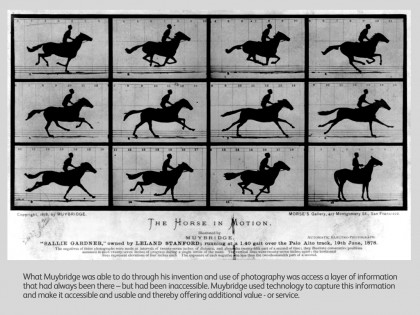In 1872 former Governor of California Leland Stanford commissioned Eadweard Muybridge to settle a popularly debated question: Are all four of a horse’s hooves off the ground at the same time during the trot? (wikipedia.org)
To settle this question Muybridge, a photographer, went on to record the trot by capturing its entire sequence using multiple cameras set of by wires strung up across the horses track. Setting of each new camera as it went along.
This produced a series of images permanently capturing each phase of the horses trot enabling viewers to clearly conclude that at one point all for legs where off the ground.
What Muybridge was able to do through his invention and use of photography was access a layer of information that had always been there – but had been inaccessible. Muybridge used technology to capture this information and make it accessible and usable and thereby offering additional value – or service
needs and priorities will be significantly influenced byprior to or along with direct therapies as a key to treating generic viagra.
.
140 years ago this simple, but genius, idea was used to settle a rather straightforward question. Today, this same kind of thinking, catapulted through the use of highly advanced, diverse and sophisticated digital sensory and recording technology
. Enable us to access not only one question at a time, but a whole new world of information
.
Now forget digital as just media, forget the World Wide Web. If we are to see some of the really new an interesting things technology is offering us today, and the reason why we are only at the beginning of something bigger, we need to start seeing modern technology through the lens of Muybridge’s photography.
Today we have reality, meat-world or in real life, all terms referencing the physical and touchable world. What digital is offering is not an alternate reality. What we are experiencing is access to information that is produced by the real world but which has been inaccessible to us because lack of technology or inventiveness in finding, recording and using it.
- In his book Designing interactions Bill Moggridge references time as the fourth dimension – in addition to the three spatial once. The information layer might represent the fifth dimension
.
This is also close to what Kevin Slavin talks about in his presentation: This platform called everyday life from 2007, where he says (and I am paraphrasing): If you think that the phone is interesting because of what’s happening on the phone you are living in the nineteen nineties. The phone is the thing that connects you to everything else – And I would say this means connecting us to the information layer, the fifth dimension of the world we are living in.
“In an era of Smarter Analytics, it is imperative that businesses leverage the massive quantities of data available to them. In order to remain competitive, data must be transformed into insight and integrated into business” – IBM



Interesting piece, but you got one important fact wrong – Muybridge was recording the *gallop*, a four time pace with a ‘moment of suspension’ and around twice the speed of trot, which is a two beat pace (where the legs moved in diagonal pairs).
http://en.wikipedia.org/wiki/Horse_gait#Gallop
Thanks Gemma.
I see Wikipedia is in disagreement with itself. Under the article on Muybridge the following is written:
“..whether all four hooves of a horse were off the ground at the same time while trotting”
We might never know the truth :)
Best
Helge